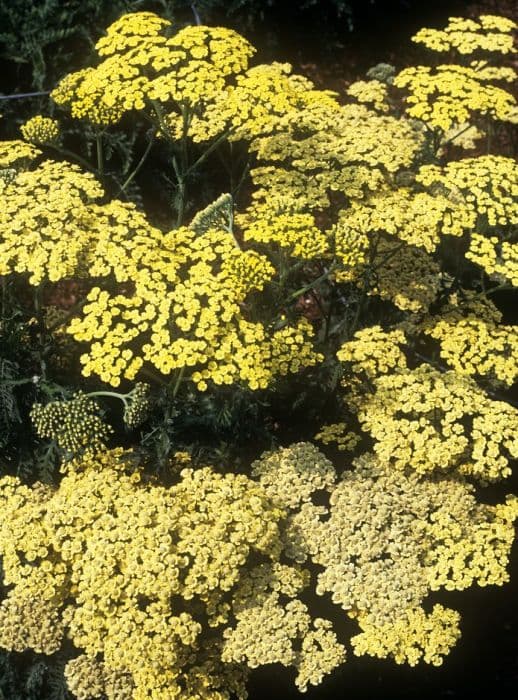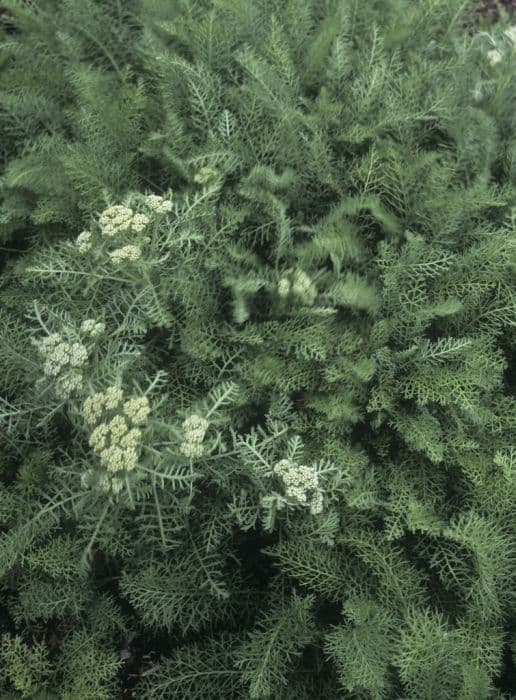Brass Buttons Cotula coronopifolia

ABOUT
Cotula coronopifolia, commonly known as brass buttons, is a perennial herbaceous plant characterized by its interesting visual appeal. This plant typically grows in a dense mat-forming habit and sports bright green, finely divided leaves that are feather-like in appearance, giving it a soft, almost fern-like texture. The foliage spreads out to create a lush ground cover, and the leaves may sometimes exhibit a slight sheen or glossiness, depending on the light. The most striking feature of brass buttons are its small, button-like flowers, which have a unique discoid shape. These flowers are usually a bright yellow color, adding a pop of vibrancy to the plant's overall appearance. The flower heads are made up of tiny, tightly clustered florets that lack the typical petal-like ray florets of daisies, leading to their distinctive round look that somewhat resembles miniature buttons. These cute and cheerful flowers sprout from the foliage on short stalks, peppering the green canvas with dots of yellow. The overall impression of brass buttons is one of dense, textured greenery punctuated by a generous scattering of yellow blooms, which can add a touch of brightness to any area where the plant is established. This ground cover can create a visually pleasing tapestry in garden settings, thriving especially well in environments that mimic its native habitats which often include damp, coastal regions.
About this plant
 Names
NamesFamily
Asteraceae
Synonyms
Brass Buttons, Golden Buttons, Buttonweed
Common names
Cotula acaulis, Strongylosperma coronopifolium, Cotula coronopifolia var. angustiloba, Cotula coronopifolia var. australasica, Cotula coronopifolia var. cardiocarpa, Cotula coronopifolia var. leptalea, Cotula coronopifolia var. virens.
 Toxicity
ToxicityTo humans
Brass buttons, the common name for Cotula coronopifolia, is not widely known for being toxic to humans. There is limited information on its toxicity for human ingestion, and it is not commonly listed as a poisonous plant. As such, there are no well-documented symptoms directly associated with the poisoning from this plant in humans. However, it is always advisable to exercise caution and avoid eating plants not recognized as safe for consumption. If any part of the plant is ingested and adverse symptoms occur, medical attention should be sought.
To pets
Brass buttons, the common name for Cotula coronopifolia, is not widely recognized as being toxic to pets. There are no strong indications that this plant poses a significant risk of poisoning to domestic animals such as dogs and cats. Nevertheless, as with any non-food plant, ingestion can sometimes lead to gastrointestinal upset or other mild symptoms due to the novelty and non-dietary nature of the material consumed. If your pet consumes parts of the brass buttons plant and shows signs of distress or illness, it is advisable to consult a veterinarian.
 Characteristics
CharacteristicsLife cycle
Perennials
Foliage type
Evergreen
Color of leaves
Green
Flower color
Yellow
Height
6 inches (15 cm)
Spread
20 inches (50 cm)
Plant type
Herb
Hardiness zones
8
Native area
South Africa
Benefits
 General Benefits
General Benefits- Erosion Control: Cotula coronopifolia has a mat-forming habit that helps stabilize the soil, preventing erosion in vulnerable areas such as slopes or banks.
- Low Maintenance: Known as brass buttons, the plant is relatively easy to care for and does not require frequent watering or fertilization, making it a low-maintenance option for gardens.
- Drought Tolerance: Brass buttons are highly tolerant of drought conditions once established, allowing them to thrive even in dry climates or during periods of water scarcity.
- Ground Cover: With its dense growth, brass buttons can effectively cover the ground, reducing the growth of weeds by limiting the amount of light and space available to them.
- Landscape Aesthetics: The small, button-like flowers and bright green foliage of brass buttons can add visual interest and texture to landscaping designs.
- Tolerates Foot Traffic: Brass buttons are resilient enough to endure moderate foot traffic, making them suitable for planting between pavers or in areas where people may walk.
- Wildlife Friendly: The flowers of brass buttons can attract beneficial insects, which are important for pollination and maintaining a balanced ecosystem.
- Soil Quality Improvement: As a part of its growth process, brass buttons can help to improve soil quality by adding organic matter when leaves and stems decompose.
- Versatility: Brass buttons can be used in a variety of landscaping situations, including rock gardens, border edging, and as a lawn substitute in certain areas.
 Medical Properties
Medical PropertiesThis plant is not used for medical purposes.
 Air-purifying Qualities
Air-purifying QualitiesThis plant is not specifically known for air purifying qualities.
 Other Uses
Other Uses- Cotula coronopifolia, commonly known as brass buttons, can be used as a ground cover in plantings due to its mat-forming habit, providing a green carpet effect in gardens.
- The dense foliage of brass buttons can help in preventing soil erosion on slopes when used in landscaping as it forms a stabilizing mat.
- The plant can be utilized in green roofs, where its drought resistance and low-growing nature contribute to sustainable building practices.
- Brass buttons might be planted between paving stones or in rock gardens for ornamental purposes, as it can tolerate some foot traffic.
- By planting brass buttons along pond margins or in wet areas of the garden, one can create an attractive transition from water to land.
- The flowers of brass buttons can be used for a natural dye, providing a range of colors depending on the mordant used in the dyeing process.
- As a companion plant, brass buttons could play a role in a polyculture garden, potentially helping to balance the ecosystem or repel certain pests.
- In craft or floristry, dried flowers of brass buttons can add a unique texture and appearance to arrangements and potpourri.
- Brass buttons, due to their unique foliage and flowering, can be used in fairy or miniature gardens as they provide a whimsical aspect to such designs.
- The plant can act as a living mulch in vegetable gardens or orchards, helping to retain soil moisture and suppress weeds.
Interesting Facts
 Feng Shui
Feng ShuiThe Brass Buttons plant is not used in Feng Shui practice.
 Zodiac Sign Compitability
Zodiac Sign CompitabilityThe Brass Buttons plant is not used in astrology practice.
 Plant Symbolism
Plant Symbolism- Healing: Cotula coronopifolia, commonly known as brass buttons, often symbolizes healing due to its medicinal properties and its use in traditional remedies.
- Adaptability: Brass buttons can thrive in various environments, representing adaptability and the ability to adjust to changing circumstances.
- Protection: The dense mat-like growth habit of brass buttons has been associated with protection, as it can prevent soil erosion and protect the land.
- Persistence: This plant's ability to spread and grow even in harsh conditions symbolizes persistence and endurance in overcoming challenges.
 Water
WaterThe Brass Buttons plant requires moist soil, so it should be watered regularly to maintain consistent moisture, especially during dry periods. Typically, watering once or twice a week during active growth is sufficient, with each watering session involving approximately one inch of water. Adjust the frequency of watering depending on weather conditions, with more frequent watering in hot, dry weather, and less when it's cooler or rainy. Ensure that the soil is well-draining to prevent waterlogging, which can lead to root rot.
 Light
LightBrass Buttons thrive best in full sunlight to partial shade. The ideal location for this plant would be a spot where it receives at least six hours of sunlight each day, ensuring vigorous growth. However, in extremely hot climates, some afternoon shade can help protect the plant from scorching.
 Temperature
TemperatureBrass Buttons plants are hardy in a wide range of temperatures but prefer a moderate climate. They can withstand minimum temperatures down to about 20 degrees Fahrenheit and can survive up to the high 80s Fahrenheit. The optimal growing temperature range for Brass Buttons is between 60 to 75 degrees Fahrenheit.
 Pruning
PruningPruning Brass Buttons is typically done to maintain its compact shape and encourage bushier growth. Prune lightly throughout the growing season as needed to remove any leggy or overgrown stems. The best time for more thorough pruning is in early spring before new growth begins.
 Cleaning
CleaningNot needed
 Soil
SoilBrass buttons prefer well-drained soil with a mix of peat, sand, and loamy components. The ideal pH range for this plant is slightly acidic to neutral, around 6.0 to 7.0. Ensuring good drainage is crucial, so incorporating perlite can help improve the soil structure.
 Repotting
RepottingBrass buttons should be repotted every one to two years to refresh the soil and accommodate root growth. It's the best time to repot in the spring before the growing season.
 Humidity & Misting
Humidity & MistingBrass buttons thrive in moderate to high humidity levels but are adaptable and can tolerate lower humidity without significant problems.
 Suitable locations
Suitable locationsIndoor
Provide bright light, avoid direct sun, and ensure soil drainage for indoor brass buttons.
Outdoor
Plant in partial shade, use well-draining soil, and space adequately for outdoor brass buttons.
Hardiness zone
5-9 USDA
 Life cycle
Life cycleCotula coronopifolia, commonly known as brass buttons, begins its life cycle as a seed, which germinates in wet, open environments often in late winter to spring. Upon germination, it develops a rosette of leaves close to the ground. As it matures, the plant elongates its stem and produces additional leaves along this stem, growing upwards and forming a bushy appearance. Flowering typically occurs in late spring to summer, presenting small, yellow, daisy-like flowers that attract pollinators and allow for sexual reproduction. After pollination, the plant produces small fruits called achenes, which contain the seeds for the next generation. As a perennial herb, brass buttons may die back during colder months, to re-sprout from the root system when conditions become favorable again.
 Propogation
PropogationPropogation time
Spring-summer
Propogation: Brass buttons, or Cotula coronopifolia, can be propagated most successfully during the spring to early summer months when conditions are mild and allow for robust growth. The popular method involves taking cuttings from a healthy parent plant. To do this, select a stem that is about 4 to 6 inches long, ensuring it has several sets of leaves. Carefully remove the lower leaves and dip the cut end into a rooting hormone to stimulate root growth. This cutting is then planted in a well-draining soil mix, and kept moist but not waterlogged. Position the pot in a location with indirect light and maintain a consistent temperature, avoiding cold drafts. With proper care, the cutting will develop roots and can eventually be transplanted outdoors or into larger containers.









